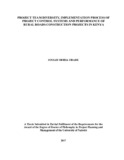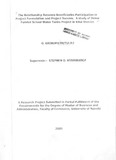Project Team Diversity, Implementation Process of Project Control Systems and Performance of Rural Roads Construction Projects in Kenya
Abstract
The aim of this study was to establish the influence of project team diversity on performance
of rural roads construction projects in Kenya. It also sought to establish the moderating
influence of implementation process of project control systems on the relationship between
project team diversity and performance of rural roads construction projects in Kenya. Six
objectives were formulated for this study. The study was anchored on ecosystem theory,
social identity theory and organisation control theory. The study applied pragmatism
paradigm and mixed methods research approaches. Cross sectional descriptive survey and
correlational research designs were adopted. A sample of 361 respondents was selected from
a target population of 3680 construction workers through stratified sampling, simple random
sampling and purposive sampling techniques. A questionnaire, observation and an interview
guide instruments were used for collecting data. In this study, data was triangulated through
comparison of qualitative data received from structured questionnaires for workers with
qualitative in-depth interviews for site engineers and observation guide by the researcher.
Qualitative data was analysed through checking data, developing codes, identifying themes
and patterns and then summarizing the data and linking them to hypothesis and objectives.
Quantitative data was then analysed and both descriptive and inferential statistics generated.
Descriptive results were presented as frequency tables, percentages, arithmetic means and
standard deviation while inferential statistics were obtained using Pearson’s Product
Moment correlation (r) and from both simple regression and multiple regression analysis. Ftest
was used to test the hypotheses. Tests of statistical assumptions were carried out before
analysis. For objective one; r = 0.788, R=0.62, F (4,192) = 285.254, p<0.001˂0.05,
therefore, H0 was rejected and concluded that project team demographic diversity
significantly influence performance of rural roads construction projects. For objective two;
r = 0.804, R=0.647, F (3,193) = 335.874 at p<0.001<0.05, H0 was rejected and concluded
that project team training diversity significantly influence performance of rural roads
construction projects. For objective three r= 0.925, R=0.855, F (2,194) = 965.321, at
p<0.001<0.05, therefore, H0 was rejected and concluded that project team experience
diversity significantly influence performance of rural roads construction projects. For
objective four; r= 0.658, R=0.432, F (3,193) = 136.735 at p<0.001<0.05, therefore, H0 was
rejected and concluded that project team work-culture diversity significantly influence
performance of rural roads construction projects. For objective five; r= 0.939, R=0.882, F
(4,192) = 358.941 at p<0.001<0.05, therefore, H0 was rejected and concluded that combined
project team diversities significantly influence performance of rural roads construction
projects. For objective six; R2 = 0.887, ΔR2= 0.005, F (5,191) = 299.871, at p<0.001<0.05,
therefore, H0 was rejected and it was concluded that the strength of the relationship between
combined project team diversities and performance of rural roads construction projects in
Kenya depends on the implementation process of project control systems. In conclusion, the
study findings provide evidence that for increased performance of rural roads construction
projects in Kenya, aspects of project team diversity should be comprehensively addressed.
It is therefore recommended that project teams in rural roads construction projects be
constituted with an integrated diversity of the workers and that a policy to that effect be
instituted and included during professional accreditation criteria for assessing performance
and awarding of tenders. The findings add to Project Management Body of Knowledge by
providing informative insights for project managers and other project management
practitioners regarding project team diversity and performance of projects. Consequently, a
similar study but with a longitudinal study approach to establish how project team diversity
influences project performance, considering other intervening and contextual factors is
recommended.
Publisher
University of Nairobi
Rights
Attribution-NonCommercial-NoDerivs 3.0 United StatesUsage Rights
http://creativecommons.org/licenses/by-nc-nd/3.0/us/Collections
- Faculty of Education (FEd) [6022]
The following license files are associated with this item:
Except where otherwise noted, this item's license is described as Attribution-NonCommercial-NoDerivs 3.0 United States
Related items
Showing items related by title, author, creator and subject.
-
Effects of application of project management cycles strategy on the success of youth projects: a case of youth enterprise development funded group projects in Nakuru North district, Kenya
Cheruiyot, Irene J (University of Nairobi, Kenya, 2012)The project cycle management provides a structure to ensure that stakeholders are consulted and relevant information is available throughout the life of the project so that informed decisions can be made at key stages on ... -
Project design factors, utilization of indigenous knowledge, project leadership and sustainability of dairy goat projects in Tharaka Nithi County, Kenya
Kikwatha, Reuben W (University of Nairobi, 2018)Evidence from the literature indicates that sustainability of development projects such as dairy goat projects is seldom realized, especially where sustainability predictors are not scrutinized. Dairy goat projects have ... -
The relationship between beneficiaries participation in project formulation and project success. A study of donor funded school water tanks project in kitui district
Mutulili, Gichuru G (University of NairobiSchool of Business, 2005)ln recent years, community participation has gained importance III community projects. Kenya successive development plans since independence in 1963 to the present, emphasis the centrality of popular participation in the ...





